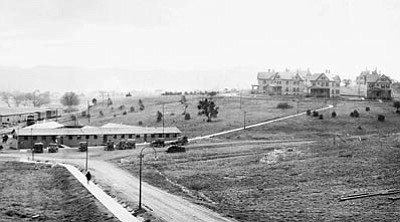By Al Bates
Al Bates, local historian, has written several articles for Days Past (1999 and 2000) about the history of Fort Whipple. The following is the last of a two-part condensed and edited rendering of those articles by Kathy Krause.
In 1872, the original buildings and stockade of Fort Whipple were demolished and more permanent frame buildings were erected on higher ground about 70-feet above Granite Creek. The official guide to posts, camps and stations declared them to be excellent quarters "in all respects."
By 1873, a military telegraph line connected Fort Whipple with San Diego, Yuma, Tucson and the newly established town of Phoenix. The military roads connecting Fort Whipple to the Indian reservations at Camp Verde and Fort McDowell formed the basis for the original Black Canyon Highway. This alternative to the established though longer Skull Valley-Wickenburg route provided Prescott residents an improved way to reach Phoenix.
By 1874, a single regiment of cavalry at Whipple handled routine patrols, Indian chases and police duty on the reservations. The Army in the next decade was a combination of a constabulary keeping order on the Indian reservations as well as a corps of laborers engaged in building military posts and roads and stringing telegraph wire. By early 1875, the fort had taken the configuration it would keep for the next 30 years.
A new post commander, Gen. August Kautz, arrived in 1874 with his wife, Fannie. Social life at the fort became foremost and nearly every week brought a social event for officers and ladies of the post. By the spring of 1877, the weekly "hops" held each Wednesday had become a Prescott institution frequently open to the enlisted men and townspeople. As of 1881, Whipple housed 136 officers and enlisted men with varied community social interaction. Supplies for the fort brought hard cash, a rare commodity at that time, to farmers and ranchers. The fort dispatched its fire company to help extinguish major town fires. Military "ambulances" (lightweight covered wagons) were loaned for funerals and to transport military offspring to school in town.
During these times there were still die-hard Native American bands and Gen. Crook dealt with them harshly. His policy was that Indians were required to stay on the assigned reservation; off the reservation, every Indian male old enough to string a bow was considered as a hostile target. He forbade any liquor on the reservation - no whiskey and no manufacture of the Apache moonshine called tizwin, which became a key factor in Geronimo's breakout in 1885 when he and 35 warriors fled thus beginning a 14-month "Geronimo War." During this time, Gen. Crook left Whipple and his replacement, Gen. Nelson Miles, was subsequently credited with Geronimo's surrender in September of 1886.
The railroad finally reached Fort Whipple in 1887. With the Indian threat over, it was time to downsize the fort. By 1895, the buildings and utilities of Whipple had deteriorated badly. The army surgeon general stated that "all the buildings at Whipple Barracks are old and dilapidated, overcrowded, drafty and poorly ventilated." Congress refused to appropriate funds for renovation and, in the autumn of 1897, the post was scheduled for deactivation. The last troops had departed, and the officer who was to "take the final inventory and lock the gate" was on hand April 25, 1898 when Congress declared war on Spain. Four days later, the closing officer became mustering officer and began enlistment of 200 men for the Spanish-American war!
The Prescott area recruits gathered at Whipple from April 29 to May 4, 1898. The captain of Troop A "Rough Riders" was William O. "Buckey" O'Neill. After the Rough Rider departure, the fort was inactive until 1902 when the Army moved in a company of infantry and the Whipple razing and reconstruction started three years later. Many of the buildings erected between 1905 and 1908 are still in use.
In 1912, Arizona achieved statehood, and Fort Whipple was declared obsolete; all but caretakers and a few hospital personnel were withdrawn. Then in May 1918, the Army reactivated Whipple, not as a fort but as a general hospital and tuberculosis sanatorium. It was transferred to the Public Health Service in 1920 for continued use as a hospital for disabled veterans. In the 1930s, the facility was transferred to the newly created Veterans Administration.
Today, Fort Whipple, now the Northern Arizona VA Health Care Complex (the Bob Stump VA Medical Center), continues to serve the people of Prescott and the surrounding area although in a way far different from its role in territorial days. "Fort Whipple" lives on today at the Fort Whipple Museum located in one of the 1909 military officer's quarters, the only building on the grounds painted in the original crème with green trim. The museum, a joint project of the Sharlot Hall Museum and the Bob Stump VA Medical Center, traces the history of the fort with exhibits and artifacts. Admission is by donation, 10 a.m. to 4 p.m. Thursdays, Fridays and Saturdays. Call 445-3122 for schedule of living history demos at the museum.
Read the three complete, informative articles by Al Bates on the history of Fort Whipple at sharlothallmuseum.org.
Sharlot Hall Museum/Courtesy photo
Whipple Barracks General Hospital No.20, as it was known in 1918 with officers’ quarters on the hill to the right.



